Managing Quality Risks and Cost in Health Care: A Detailed Report
VerifiedAdded on 2019/10/01
|9
|2498
|44
Report
AI Summary
This report examines the value-based healthcare model employed by the Cleveland Clinic, analyzing its impact on quality, cost, and patient satisfaction. The study involves a case study and historical analysis of the clinic's operations, focusing on strategies for delivering high-quality care at affordable costs. The report identifies key components of the clinic's approach, including technological advancements and empathetic patient care. It then proposes three options from this model for implementation in a New South Wales (NSW) hospital, addressing potential barriers to adoption. The report concludes with recommendations for enhancing healthcare delivery and improving patient outcomes by adapting value-based strategies.
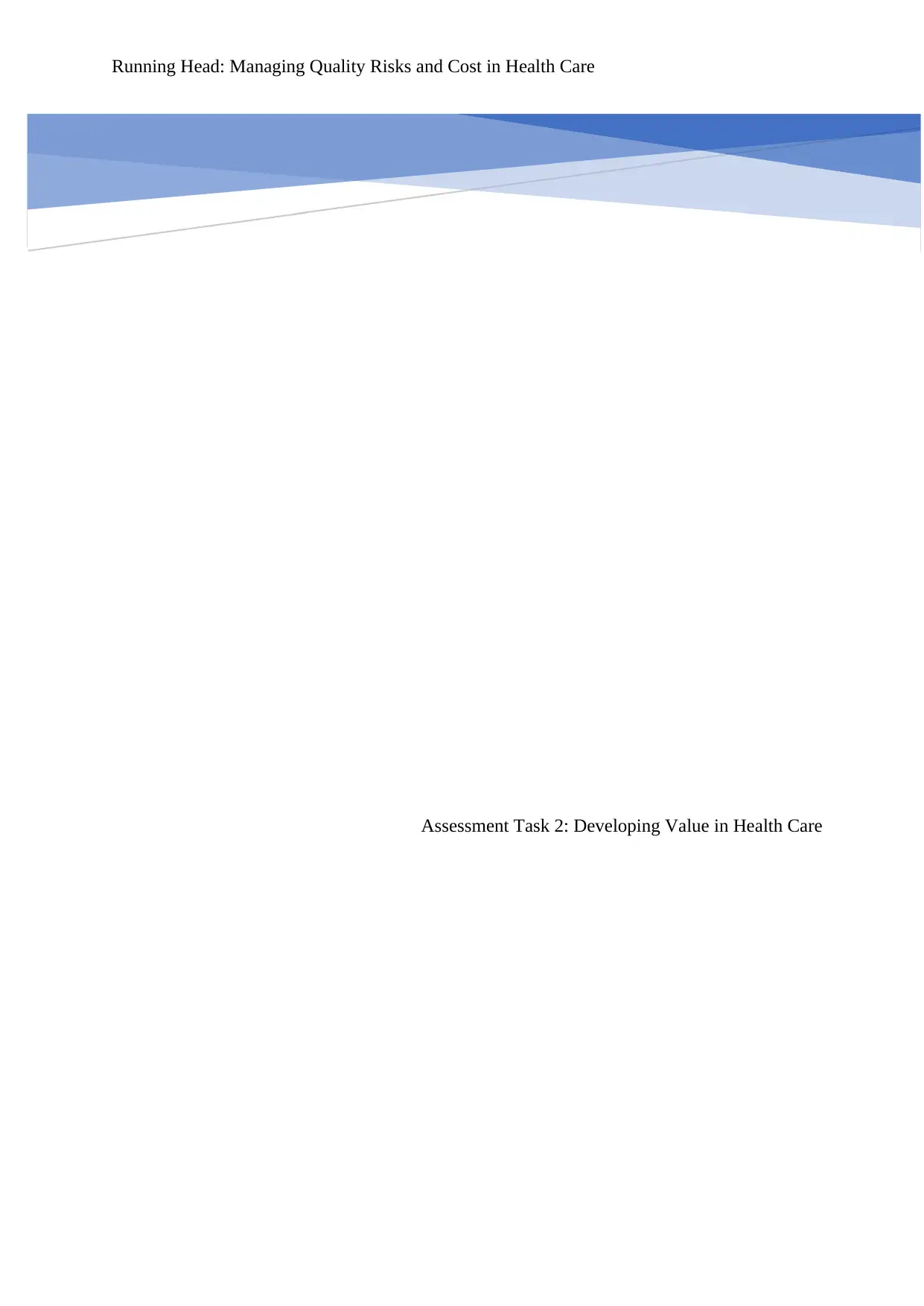
Running Head: Managing Quality Risks and Cost in Health Care
Assessment Task 2: Developing Value in Health Care
Assessment Task 2: Developing Value in Health Care
Paraphrase This Document
Need a fresh take? Get an instant paraphrase of this document with our AI Paraphraser
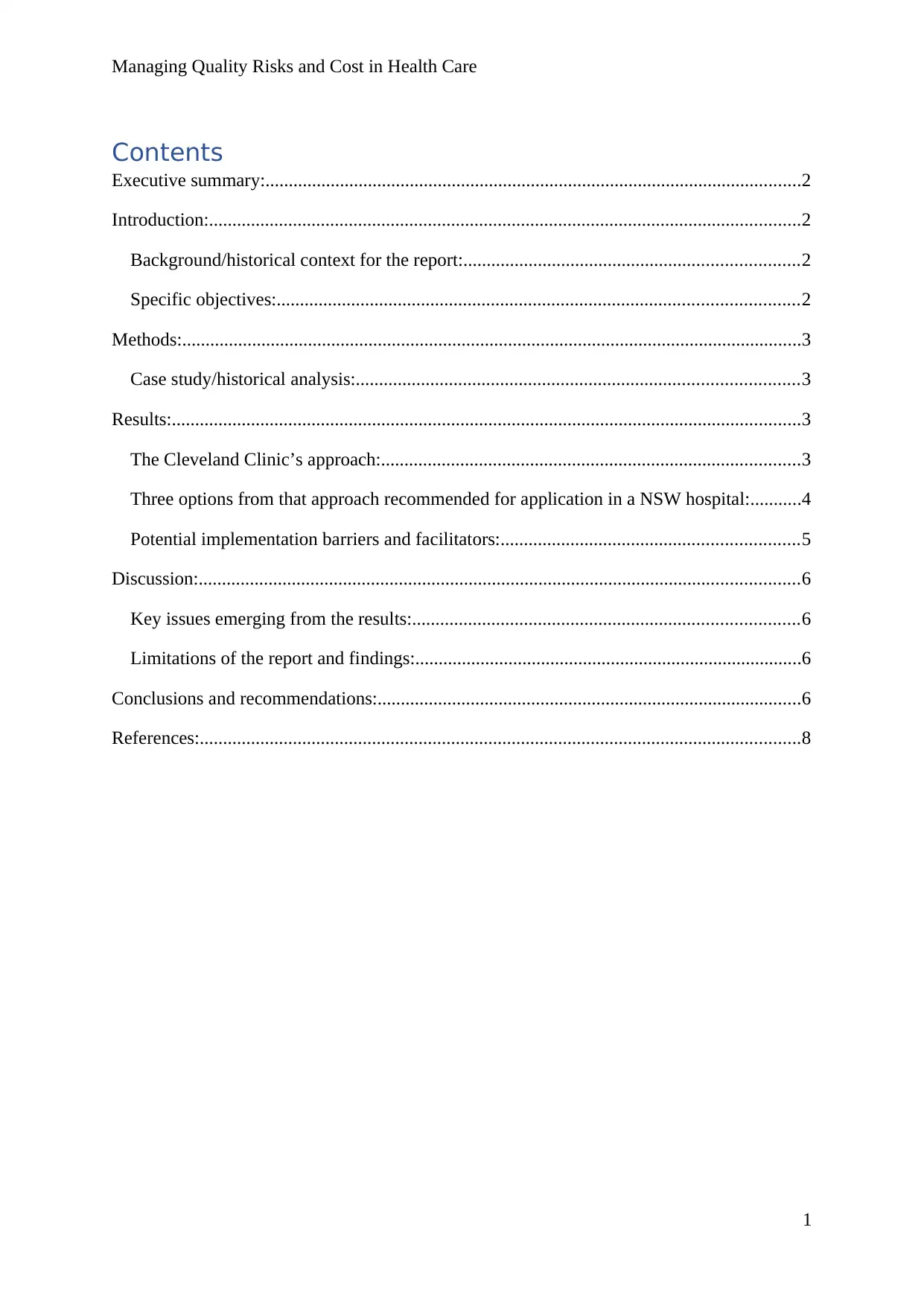
Managing Quality Risks and Cost in Health Care
Contents
Executive summary:...................................................................................................................2
Introduction:...............................................................................................................................2
Background/historical context for the report:........................................................................2
Specific objectives:................................................................................................................2
Methods:.....................................................................................................................................3
Case study/historical analysis:...............................................................................................3
Results:.......................................................................................................................................3
The Cleveland Clinic’s approach:..........................................................................................3
Three options from that approach recommended for application in a NSW hospital:...........4
Potential implementation barriers and facilitators:................................................................5
Discussion:.................................................................................................................................6
Key issues emerging from the results:...................................................................................6
Limitations of the report and findings:...................................................................................6
Conclusions and recommendations:...........................................................................................6
References:.................................................................................................................................8
1
Contents
Executive summary:...................................................................................................................2
Introduction:...............................................................................................................................2
Background/historical context for the report:........................................................................2
Specific objectives:................................................................................................................2
Methods:.....................................................................................................................................3
Case study/historical analysis:...............................................................................................3
Results:.......................................................................................................................................3
The Cleveland Clinic’s approach:..........................................................................................3
Three options from that approach recommended for application in a NSW hospital:...........4
Potential implementation barriers and facilitators:................................................................5
Discussion:.................................................................................................................................6
Key issues emerging from the results:...................................................................................6
Limitations of the report and findings:...................................................................................6
Conclusions and recommendations:...........................................................................................6
References:.................................................................................................................................8
1

Managing Quality Risks and Cost in Health Care
Executive summary:
This report elicits a modern framework of healthcare service delivery that is known as the
value-based healthcare service delivery being observed at the Cleveland Clinic in the US. An
analysis has been conducted during a study tour on the operations of the healthcare
establishment in order to gather key inputs regarding the service framework observed by the
reputed clinic and the results that are visible in terms of the customer satisfaction, growth,
profitability and sustainability. The main purpose was to implement a more advanced
healthcare delivery framework at a hospital in New South Wales such that a holistic
improvement in the service delivery and patient satisfaction might be achieved by the clinic
by following the footsteps of the Cleveland Clinic.
Introduction:
Background/historical context for the report:
The purpose of this report was to evaluate the healthcare delivery framework observed at the
Cleveland Clinic in the US and determine the pros and cons of the service delivery
framework that was being observed at the clinic. The management of the hospital at New
South Wales wishes to implement a more advanced and logical model of health service
delivery in order to offer better services to the patients and enhance the customer satisfaction
manifold.
Specific objectives:
The specific objectives behind the preparation of this report were as follows:
To determine the healthcare model being observed at the Cleveland Clinic in US and
find out its advantages and disadvantages.
To evaluate the value-based healthcare service delivery model in-depth.
To find out the effect of the value-based healthcare service delivery on patient
satisfaction.
To propose the implementation of the value-based healthcare service delivery to the
management of the NSW hospital.
To successfully resolve the resistance that might emerge from the change
management strategy.
2
Executive summary:
This report elicits a modern framework of healthcare service delivery that is known as the
value-based healthcare service delivery being observed at the Cleveland Clinic in the US. An
analysis has been conducted during a study tour on the operations of the healthcare
establishment in order to gather key inputs regarding the service framework observed by the
reputed clinic and the results that are visible in terms of the customer satisfaction, growth,
profitability and sustainability. The main purpose was to implement a more advanced
healthcare delivery framework at a hospital in New South Wales such that a holistic
improvement in the service delivery and patient satisfaction might be achieved by the clinic
by following the footsteps of the Cleveland Clinic.
Introduction:
Background/historical context for the report:
The purpose of this report was to evaluate the healthcare delivery framework observed at the
Cleveland Clinic in the US and determine the pros and cons of the service delivery
framework that was being observed at the clinic. The management of the hospital at New
South Wales wishes to implement a more advanced and logical model of health service
delivery in order to offer better services to the patients and enhance the customer satisfaction
manifold.
Specific objectives:
The specific objectives behind the preparation of this report were as follows:
To determine the healthcare model being observed at the Cleveland Clinic in US and
find out its advantages and disadvantages.
To evaluate the value-based healthcare service delivery model in-depth.
To find out the effect of the value-based healthcare service delivery on patient
satisfaction.
To propose the implementation of the value-based healthcare service delivery to the
management of the NSW hospital.
To successfully resolve the resistance that might emerge from the change
management strategy.
2
⊘ This is a preview!⊘
Do you want full access?
Subscribe today to unlock all pages.

Trusted by 1+ million students worldwide
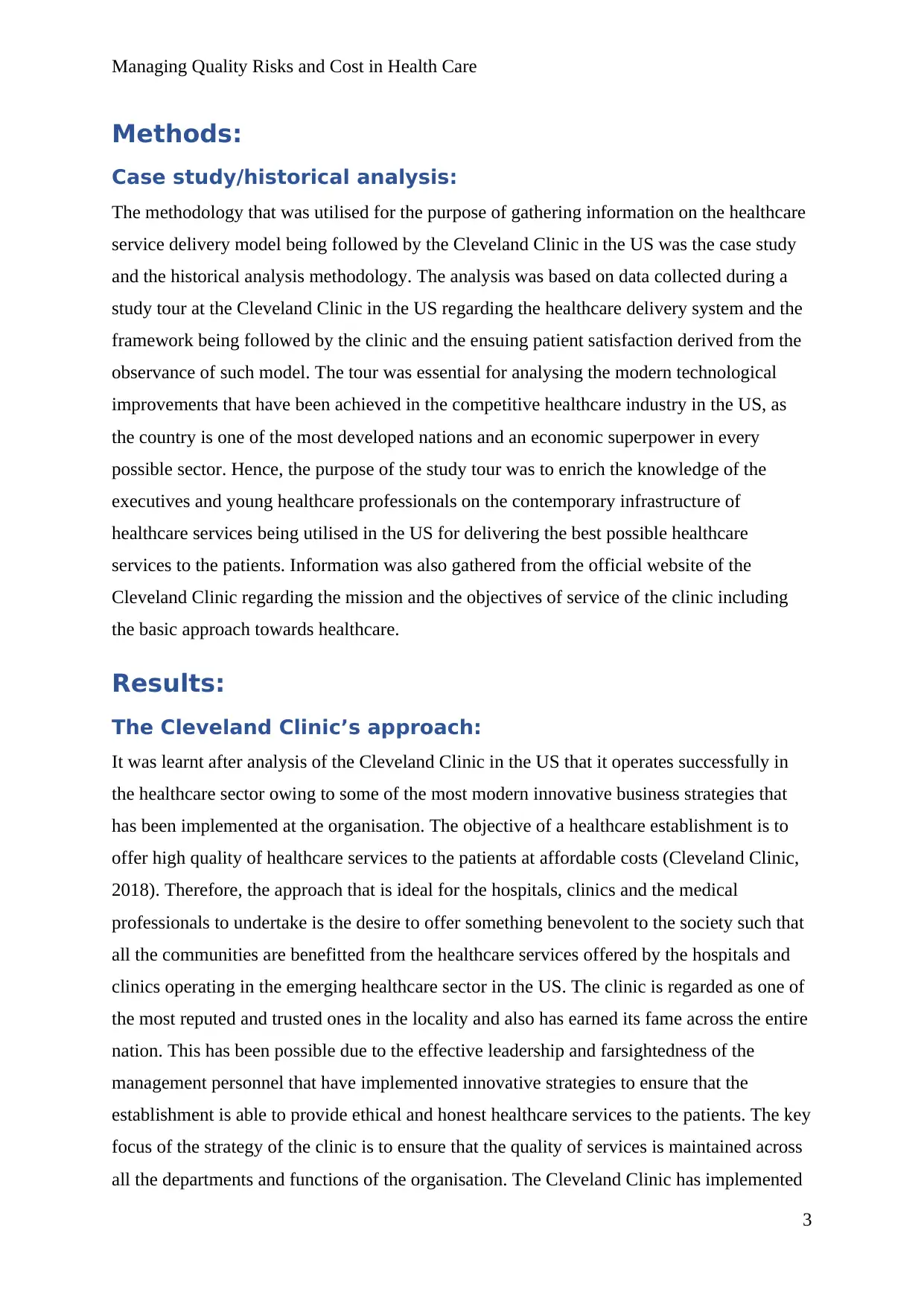
Managing Quality Risks and Cost in Health Care
Methods:
Case study/historical analysis:
The methodology that was utilised for the purpose of gathering information on the healthcare
service delivery model being followed by the Cleveland Clinic in the US was the case study
and the historical analysis methodology. The analysis was based on data collected during a
study tour at the Cleveland Clinic in the US regarding the healthcare delivery system and the
framework being followed by the clinic and the ensuing patient satisfaction derived from the
observance of such model. The tour was essential for analysing the modern technological
improvements that have been achieved in the competitive healthcare industry in the US, as
the country is one of the most developed nations and an economic superpower in every
possible sector. Hence, the purpose of the study tour was to enrich the knowledge of the
executives and young healthcare professionals on the contemporary infrastructure of
healthcare services being utilised in the US for delivering the best possible healthcare
services to the patients. Information was also gathered from the official website of the
Cleveland Clinic regarding the mission and the objectives of service of the clinic including
the basic approach towards healthcare.
Results:
The Cleveland Clinic’s approach:
It was learnt after analysis of the Cleveland Clinic in the US that it operates successfully in
the healthcare sector owing to some of the most modern innovative business strategies that
has been implemented at the organisation. The objective of a healthcare establishment is to
offer high quality of healthcare services to the patients at affordable costs (Cleveland Clinic,
2018). Therefore, the approach that is ideal for the hospitals, clinics and the medical
professionals to undertake is the desire to offer something benevolent to the society such that
all the communities are benefitted from the healthcare services offered by the hospitals and
clinics operating in the emerging healthcare sector in the US. The clinic is regarded as one of
the most reputed and trusted ones in the locality and also has earned its fame across the entire
nation. This has been possible due to the effective leadership and farsightedness of the
management personnel that have implemented innovative strategies to ensure that the
establishment is able to provide ethical and honest healthcare services to the patients. The key
focus of the strategy of the clinic is to ensure that the quality of services is maintained across
all the departments and functions of the organisation. The Cleveland Clinic has implemented
3
Methods:
Case study/historical analysis:
The methodology that was utilised for the purpose of gathering information on the healthcare
service delivery model being followed by the Cleveland Clinic in the US was the case study
and the historical analysis methodology. The analysis was based on data collected during a
study tour at the Cleveland Clinic in the US regarding the healthcare delivery system and the
framework being followed by the clinic and the ensuing patient satisfaction derived from the
observance of such model. The tour was essential for analysing the modern technological
improvements that have been achieved in the competitive healthcare industry in the US, as
the country is one of the most developed nations and an economic superpower in every
possible sector. Hence, the purpose of the study tour was to enrich the knowledge of the
executives and young healthcare professionals on the contemporary infrastructure of
healthcare services being utilised in the US for delivering the best possible healthcare
services to the patients. Information was also gathered from the official website of the
Cleveland Clinic regarding the mission and the objectives of service of the clinic including
the basic approach towards healthcare.
Results:
The Cleveland Clinic’s approach:
It was learnt after analysis of the Cleveland Clinic in the US that it operates successfully in
the healthcare sector owing to some of the most modern innovative business strategies that
has been implemented at the organisation. The objective of a healthcare establishment is to
offer high quality of healthcare services to the patients at affordable costs (Cleveland Clinic,
2018). Therefore, the approach that is ideal for the hospitals, clinics and the medical
professionals to undertake is the desire to offer something benevolent to the society such that
all the communities are benefitted from the healthcare services offered by the hospitals and
clinics operating in the emerging healthcare sector in the US. The clinic is regarded as one of
the most reputed and trusted ones in the locality and also has earned its fame across the entire
nation. This has been possible due to the effective leadership and farsightedness of the
management personnel that have implemented innovative strategies to ensure that the
establishment is able to provide ethical and honest healthcare services to the patients. The key
focus of the strategy of the clinic is to ensure that the quality of services is maintained across
all the departments and functions of the organisation. The Cleveland Clinic has implemented
3
Paraphrase This Document
Need a fresh take? Get an instant paraphrase of this document with our AI Paraphraser
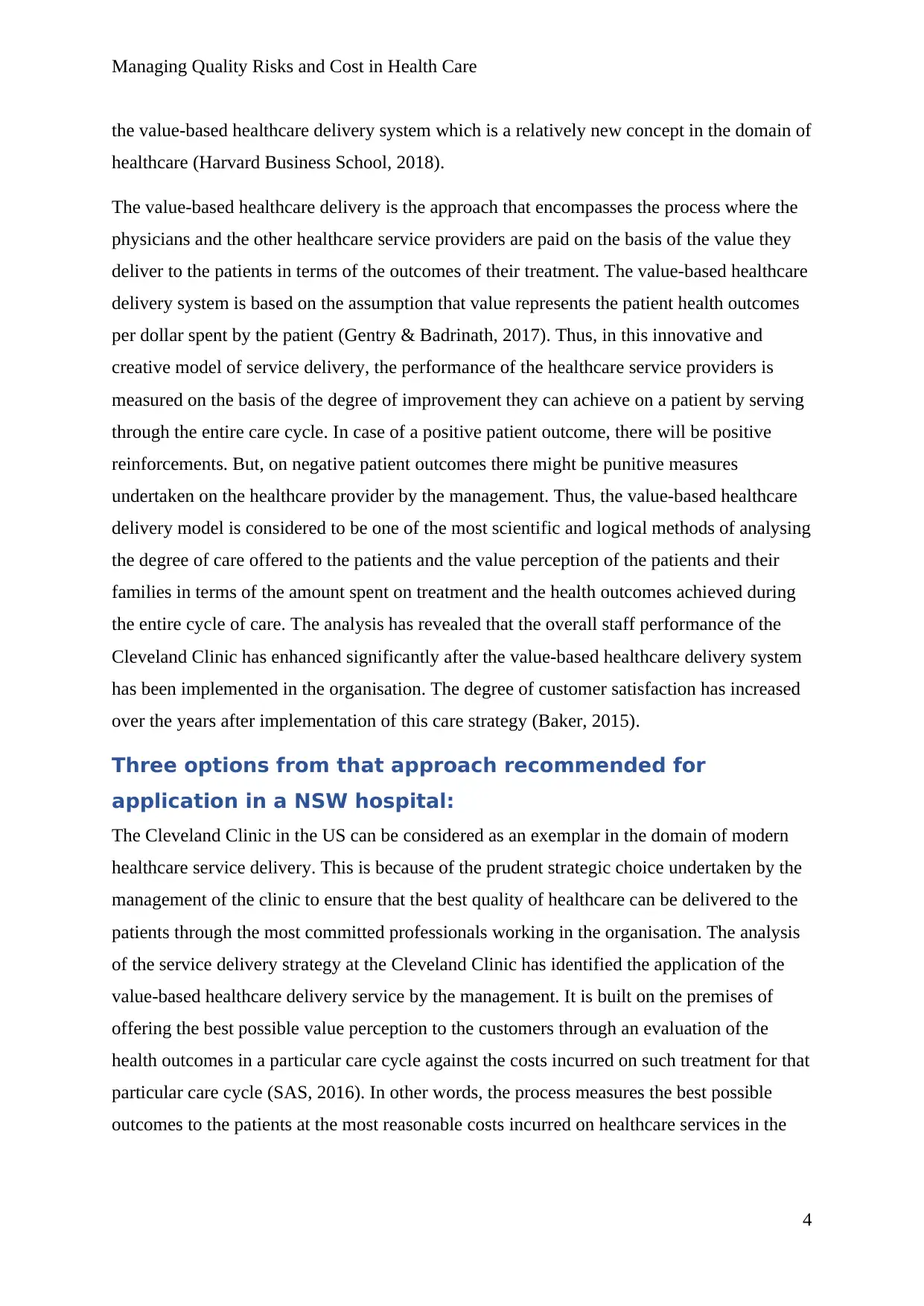
Managing Quality Risks and Cost in Health Care
the value-based healthcare delivery system which is a relatively new concept in the domain of
healthcare (Harvard Business School, 2018).
The value-based healthcare delivery is the approach that encompasses the process where the
physicians and the other healthcare service providers are paid on the basis of the value they
deliver to the patients in terms of the outcomes of their treatment. The value-based healthcare
delivery system is based on the assumption that value represents the patient health outcomes
per dollar spent by the patient (Gentry & Badrinath, 2017). Thus, in this innovative and
creative model of service delivery, the performance of the healthcare service providers is
measured on the basis of the degree of improvement they can achieve on a patient by serving
through the entire care cycle. In case of a positive patient outcome, there will be positive
reinforcements. But, on negative patient outcomes there might be punitive measures
undertaken on the healthcare provider by the management. Thus, the value-based healthcare
delivery model is considered to be one of the most scientific and logical methods of analysing
the degree of care offered to the patients and the value perception of the patients and their
families in terms of the amount spent on treatment and the health outcomes achieved during
the entire cycle of care. The analysis has revealed that the overall staff performance of the
Cleveland Clinic has enhanced significantly after the value-based healthcare delivery system
has been implemented in the organisation. The degree of customer satisfaction has increased
over the years after implementation of this care strategy (Baker, 2015).
Three options from that approach recommended for
application in a NSW hospital:
The Cleveland Clinic in the US can be considered as an exemplar in the domain of modern
healthcare service delivery. This is because of the prudent strategic choice undertaken by the
management of the clinic to ensure that the best quality of healthcare can be delivered to the
patients through the most committed professionals working in the organisation. The analysis
of the service delivery strategy at the Cleveland Clinic has identified the application of the
value-based healthcare delivery service by the management. It is built on the premises of
offering the best possible value perception to the customers through an evaluation of the
health outcomes in a particular care cycle against the costs incurred on such treatment for that
particular care cycle (SAS, 2016). In other words, the process measures the best possible
outcomes to the patients at the most reasonable costs incurred on healthcare services in the
4
the value-based healthcare delivery system which is a relatively new concept in the domain of
healthcare (Harvard Business School, 2018).
The value-based healthcare delivery is the approach that encompasses the process where the
physicians and the other healthcare service providers are paid on the basis of the value they
deliver to the patients in terms of the outcomes of their treatment. The value-based healthcare
delivery system is based on the assumption that value represents the patient health outcomes
per dollar spent by the patient (Gentry & Badrinath, 2017). Thus, in this innovative and
creative model of service delivery, the performance of the healthcare service providers is
measured on the basis of the degree of improvement they can achieve on a patient by serving
through the entire care cycle. In case of a positive patient outcome, there will be positive
reinforcements. But, on negative patient outcomes there might be punitive measures
undertaken on the healthcare provider by the management. Thus, the value-based healthcare
delivery model is considered to be one of the most scientific and logical methods of analysing
the degree of care offered to the patients and the value perception of the patients and their
families in terms of the amount spent on treatment and the health outcomes achieved during
the entire cycle of care. The analysis has revealed that the overall staff performance of the
Cleveland Clinic has enhanced significantly after the value-based healthcare delivery system
has been implemented in the organisation. The degree of customer satisfaction has increased
over the years after implementation of this care strategy (Baker, 2015).
Three options from that approach recommended for
application in a NSW hospital:
The Cleveland Clinic in the US can be considered as an exemplar in the domain of modern
healthcare service delivery. This is because of the prudent strategic choice undertaken by the
management of the clinic to ensure that the best quality of healthcare can be delivered to the
patients through the most committed professionals working in the organisation. The analysis
of the service delivery strategy at the Cleveland Clinic has identified the application of the
value-based healthcare delivery service by the management. It is built on the premises of
offering the best possible value perception to the customers through an evaluation of the
health outcomes in a particular care cycle against the costs incurred on such treatment for that
particular care cycle (SAS, 2016). In other words, the process measures the best possible
outcomes to the patients at the most reasonable costs incurred on healthcare services in the
4
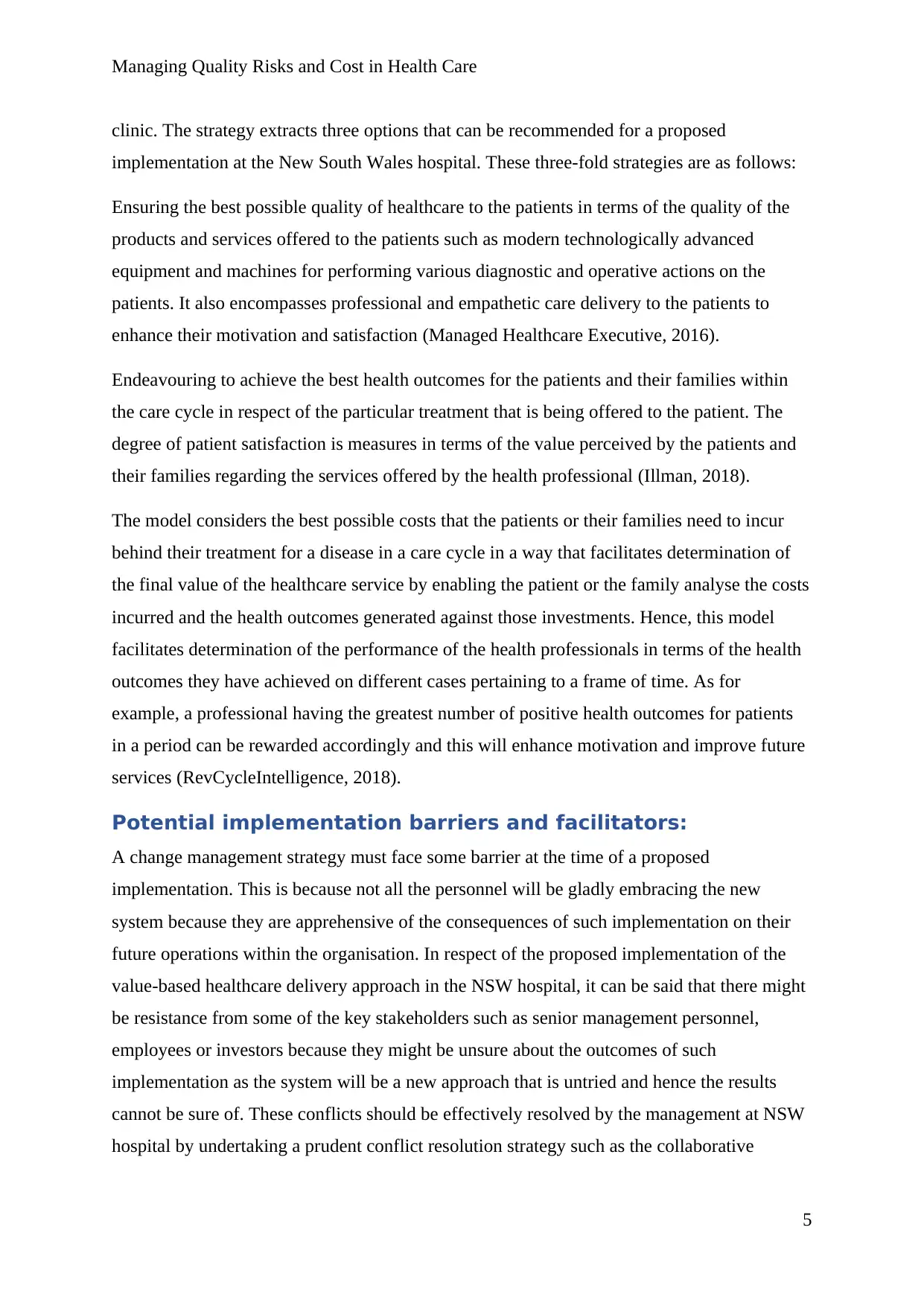
Managing Quality Risks and Cost in Health Care
clinic. The strategy extracts three options that can be recommended for a proposed
implementation at the New South Wales hospital. These three-fold strategies are as follows:
Ensuring the best possible quality of healthcare to the patients in terms of the quality of the
products and services offered to the patients such as modern technologically advanced
equipment and machines for performing various diagnostic and operative actions on the
patients. It also encompasses professional and empathetic care delivery to the patients to
enhance their motivation and satisfaction (Managed Healthcare Executive, 2016).
Endeavouring to achieve the best health outcomes for the patients and their families within
the care cycle in respect of the particular treatment that is being offered to the patient. The
degree of patient satisfaction is measures in terms of the value perceived by the patients and
their families regarding the services offered by the health professional (Illman, 2018).
The model considers the best possible costs that the patients or their families need to incur
behind their treatment for a disease in a care cycle in a way that facilitates determination of
the final value of the healthcare service by enabling the patient or the family analyse the costs
incurred and the health outcomes generated against those investments. Hence, this model
facilitates determination of the performance of the health professionals in terms of the health
outcomes they have achieved on different cases pertaining to a frame of time. As for
example, a professional having the greatest number of positive health outcomes for patients
in a period can be rewarded accordingly and this will enhance motivation and improve future
services (RevCycleIntelligence, 2018).
Potential implementation barriers and facilitators:
A change management strategy must face some barrier at the time of a proposed
implementation. This is because not all the personnel will be gladly embracing the new
system because they are apprehensive of the consequences of such implementation on their
future operations within the organisation. In respect of the proposed implementation of the
value-based healthcare delivery approach in the NSW hospital, it can be said that there might
be resistance from some of the key stakeholders such as senior management personnel,
employees or investors because they might be unsure about the outcomes of such
implementation as the system will be a new approach that is untried and hence the results
cannot be sure of. These conflicts should be effectively resolved by the management at NSW
hospital by undertaking a prudent conflict resolution strategy such as the collaborative
5
clinic. The strategy extracts three options that can be recommended for a proposed
implementation at the New South Wales hospital. These three-fold strategies are as follows:
Ensuring the best possible quality of healthcare to the patients in terms of the quality of the
products and services offered to the patients such as modern technologically advanced
equipment and machines for performing various diagnostic and operative actions on the
patients. It also encompasses professional and empathetic care delivery to the patients to
enhance their motivation and satisfaction (Managed Healthcare Executive, 2016).
Endeavouring to achieve the best health outcomes for the patients and their families within
the care cycle in respect of the particular treatment that is being offered to the patient. The
degree of patient satisfaction is measures in terms of the value perceived by the patients and
their families regarding the services offered by the health professional (Illman, 2018).
The model considers the best possible costs that the patients or their families need to incur
behind their treatment for a disease in a care cycle in a way that facilitates determination of
the final value of the healthcare service by enabling the patient or the family analyse the costs
incurred and the health outcomes generated against those investments. Hence, this model
facilitates determination of the performance of the health professionals in terms of the health
outcomes they have achieved on different cases pertaining to a frame of time. As for
example, a professional having the greatest number of positive health outcomes for patients
in a period can be rewarded accordingly and this will enhance motivation and improve future
services (RevCycleIntelligence, 2018).
Potential implementation barriers and facilitators:
A change management strategy must face some barrier at the time of a proposed
implementation. This is because not all the personnel will be gladly embracing the new
system because they are apprehensive of the consequences of such implementation on their
future operations within the organisation. In respect of the proposed implementation of the
value-based healthcare delivery approach in the NSW hospital, it can be said that there might
be resistance from some of the key stakeholders such as senior management personnel,
employees or investors because they might be unsure about the outcomes of such
implementation as the system will be a new approach that is untried and hence the results
cannot be sure of. These conflicts should be effectively resolved by the management at NSW
hospital by undertaking a prudent conflict resolution strategy such as the collaborative
5
⊘ This is a preview!⊘
Do you want full access?
Subscribe today to unlock all pages.

Trusted by 1+ million students worldwide
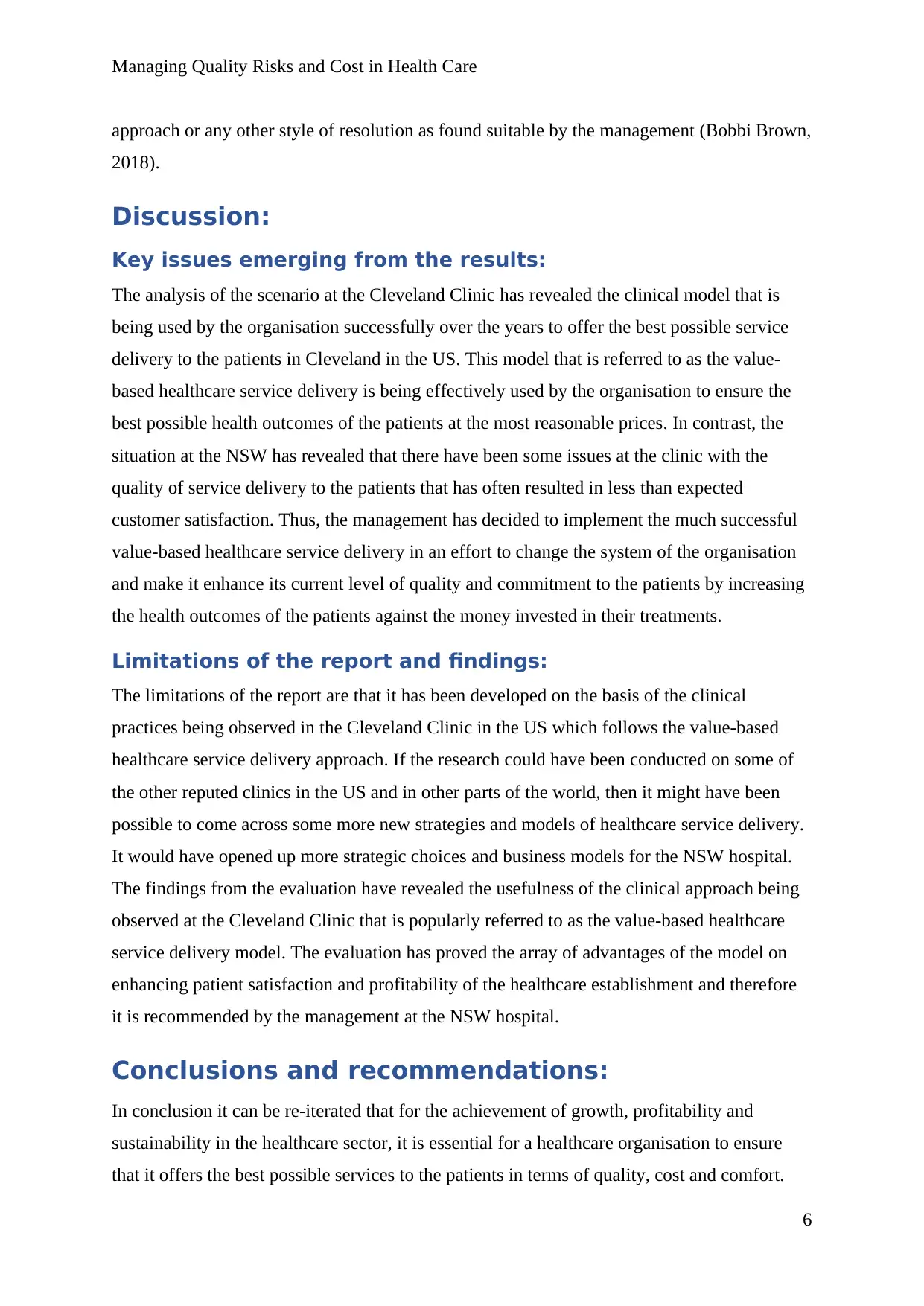
Managing Quality Risks and Cost in Health Care
approach or any other style of resolution as found suitable by the management (Bobbi Brown,
2018).
Discussion:
Key issues emerging from the results:
The analysis of the scenario at the Cleveland Clinic has revealed the clinical model that is
being used by the organisation successfully over the years to offer the best possible service
delivery to the patients in Cleveland in the US. This model that is referred to as the value-
based healthcare service delivery is being effectively used by the organisation to ensure the
best possible health outcomes of the patients at the most reasonable prices. In contrast, the
situation at the NSW has revealed that there have been some issues at the clinic with the
quality of service delivery to the patients that has often resulted in less than expected
customer satisfaction. Thus, the management has decided to implement the much successful
value-based healthcare service delivery in an effort to change the system of the organisation
and make it enhance its current level of quality and commitment to the patients by increasing
the health outcomes of the patients against the money invested in their treatments.
Limitations of the report and findings:
The limitations of the report are that it has been developed on the basis of the clinical
practices being observed in the Cleveland Clinic in the US which follows the value-based
healthcare service delivery approach. If the research could have been conducted on some of
the other reputed clinics in the US and in other parts of the world, then it might have been
possible to come across some more new strategies and models of healthcare service delivery.
It would have opened up more strategic choices and business models for the NSW hospital.
The findings from the evaluation have revealed the usefulness of the clinical approach being
observed at the Cleveland Clinic that is popularly referred to as the value-based healthcare
service delivery model. The evaluation has proved the array of advantages of the model on
enhancing patient satisfaction and profitability of the healthcare establishment and therefore
it is recommended by the management at the NSW hospital.
Conclusions and recommendations:
In conclusion it can be re-iterated that for the achievement of growth, profitability and
sustainability in the healthcare sector, it is essential for a healthcare organisation to ensure
that it offers the best possible services to the patients in terms of quality, cost and comfort.
6
approach or any other style of resolution as found suitable by the management (Bobbi Brown,
2018).
Discussion:
Key issues emerging from the results:
The analysis of the scenario at the Cleveland Clinic has revealed the clinical model that is
being used by the organisation successfully over the years to offer the best possible service
delivery to the patients in Cleveland in the US. This model that is referred to as the value-
based healthcare service delivery is being effectively used by the organisation to ensure the
best possible health outcomes of the patients at the most reasonable prices. In contrast, the
situation at the NSW has revealed that there have been some issues at the clinic with the
quality of service delivery to the patients that has often resulted in less than expected
customer satisfaction. Thus, the management has decided to implement the much successful
value-based healthcare service delivery in an effort to change the system of the organisation
and make it enhance its current level of quality and commitment to the patients by increasing
the health outcomes of the patients against the money invested in their treatments.
Limitations of the report and findings:
The limitations of the report are that it has been developed on the basis of the clinical
practices being observed in the Cleveland Clinic in the US which follows the value-based
healthcare service delivery approach. If the research could have been conducted on some of
the other reputed clinics in the US and in other parts of the world, then it might have been
possible to come across some more new strategies and models of healthcare service delivery.
It would have opened up more strategic choices and business models for the NSW hospital.
The findings from the evaluation have revealed the usefulness of the clinical approach being
observed at the Cleveland Clinic that is popularly referred to as the value-based healthcare
service delivery model. The evaluation has proved the array of advantages of the model on
enhancing patient satisfaction and profitability of the healthcare establishment and therefore
it is recommended by the management at the NSW hospital.
Conclusions and recommendations:
In conclusion it can be re-iterated that for the achievement of growth, profitability and
sustainability in the healthcare sector, it is essential for a healthcare organisation to ensure
that it offers the best possible services to the patients in terms of quality, cost and comfort.
6
Paraphrase This Document
Need a fresh take? Get an instant paraphrase of this document with our AI Paraphraser
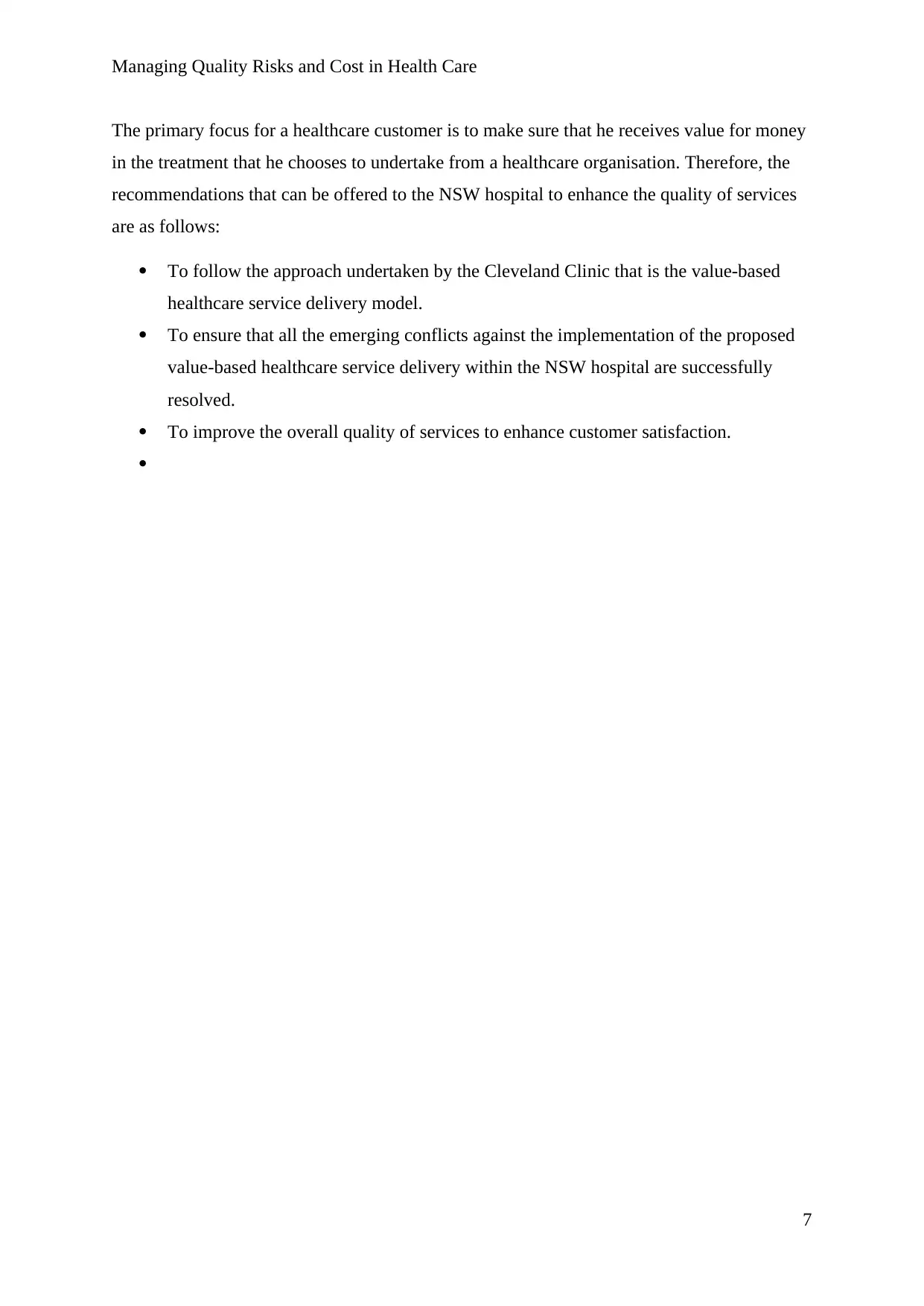
Managing Quality Risks and Cost in Health Care
The primary focus for a healthcare customer is to make sure that he receives value for money
in the treatment that he chooses to undertake from a healthcare organisation. Therefore, the
recommendations that can be offered to the NSW hospital to enhance the quality of services
are as follows:
To follow the approach undertaken by the Cleveland Clinic that is the value-based
healthcare service delivery model.
To ensure that all the emerging conflicts against the implementation of the proposed
value-based healthcare service delivery within the NSW hospital are successfully
resolved.
To improve the overall quality of services to enhance customer satisfaction.
7
The primary focus for a healthcare customer is to make sure that he receives value for money
in the treatment that he chooses to undertake from a healthcare organisation. Therefore, the
recommendations that can be offered to the NSW hospital to enhance the quality of services
are as follows:
To follow the approach undertaken by the Cleveland Clinic that is the value-based
healthcare service delivery model.
To ensure that all the emerging conflicts against the implementation of the proposed
value-based healthcare service delivery within the NSW hospital are successfully
resolved.
To improve the overall quality of services to enhance customer satisfaction.
7

Managing Quality Risks and Cost in Health Care
References:
Baker, T., 2015. 2 Benefits to Implementing Value Based Purchasing Initiatives. [Online]
Available at: http://www.mdvaluate.com/blog/2-benefits-to-implementing-value-based-
purchasing-initiatives
Bobbi Brown, J. C., 2018. https://www.healthcatalyst.com/insights/hospital-transitioning-
fee-for-service-value-based-reimbursements. [Online]
Available at: https://www.healthcatalyst.com/insights/hospital-transitioning-fee-for-service-
value-based-reimbursements
Cleveland Clinic, 2018. Our Model of Healthcare. [Online]
Available at: https://my.clevelandclinic.org/about/overview/our-model-healthcare
Gentry, S. & Badrinath, P., 2017. Defining Health in the Era of Value-based Care: Lessons
from England of Relevance to Other Health Systems. Cureusv.9(3).
Harvard Business School, 2018. Value-Based Health Care Delivery. [Online]
Available at: https://www.isc.hbs.edu/health-care/vbhcd/Pages/default.aspx
Illman, J., 2018. The benefits of value-based healthcare. [Online]
Available at: https://www.raconteur.net/healthcare/benefits-value-based-healthcare
Managed Healthcare Executive, 2016. Top 5 ways value-based pricing impacts healthcare.
[Online]
Available at: http://www.managedhealthcareexecutive.com/benefit-design-and-pricing/top-5-
ways-value-based-pricing-impacts-healthcare
RevCycleIntelligence, 2018. What Is Value-Based Care, What It Means for Providers?.
[Online]
Available at: https://revcycleintelligence.com/features/what-is-value-based-care-what-it-
means-for-providers
SAS, 2016. Value-based healthcare: the ‘fix it’ strategy for the UK?. [Online]
Available at: https://www.sas.com/content/dam/SAS/en_gb/doc/research1/value-based-
healthcare-research-paper.pdf
8
References:
Baker, T., 2015. 2 Benefits to Implementing Value Based Purchasing Initiatives. [Online]
Available at: http://www.mdvaluate.com/blog/2-benefits-to-implementing-value-based-
purchasing-initiatives
Bobbi Brown, J. C., 2018. https://www.healthcatalyst.com/insights/hospital-transitioning-
fee-for-service-value-based-reimbursements. [Online]
Available at: https://www.healthcatalyst.com/insights/hospital-transitioning-fee-for-service-
value-based-reimbursements
Cleveland Clinic, 2018. Our Model of Healthcare. [Online]
Available at: https://my.clevelandclinic.org/about/overview/our-model-healthcare
Gentry, S. & Badrinath, P., 2017. Defining Health in the Era of Value-based Care: Lessons
from England of Relevance to Other Health Systems. Cureusv.9(3).
Harvard Business School, 2018. Value-Based Health Care Delivery. [Online]
Available at: https://www.isc.hbs.edu/health-care/vbhcd/Pages/default.aspx
Illman, J., 2018. The benefits of value-based healthcare. [Online]
Available at: https://www.raconteur.net/healthcare/benefits-value-based-healthcare
Managed Healthcare Executive, 2016. Top 5 ways value-based pricing impacts healthcare.
[Online]
Available at: http://www.managedhealthcareexecutive.com/benefit-design-and-pricing/top-5-
ways-value-based-pricing-impacts-healthcare
RevCycleIntelligence, 2018. What Is Value-Based Care, What It Means for Providers?.
[Online]
Available at: https://revcycleintelligence.com/features/what-is-value-based-care-what-it-
means-for-providers
SAS, 2016. Value-based healthcare: the ‘fix it’ strategy for the UK?. [Online]
Available at: https://www.sas.com/content/dam/SAS/en_gb/doc/research1/value-based-
healthcare-research-paper.pdf
8
⊘ This is a preview!⊘
Do you want full access?
Subscribe today to unlock all pages.

Trusted by 1+ million students worldwide
1 out of 9
Related Documents
Your All-in-One AI-Powered Toolkit for Academic Success.
+13062052269
info@desklib.com
Available 24*7 on WhatsApp / Email
![[object Object]](/_next/static/media/star-bottom.7253800d.svg)
Unlock your academic potential
Copyright © 2020–2025 A2Z Services. All Rights Reserved. Developed and managed by ZUCOL.




